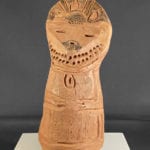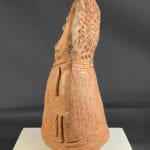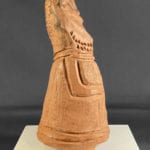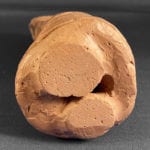The depth (front to back) varies from 2.875″ at base to 1.875′ at the necklace to 1.5625′ at the chin and 0.875″ at the tabula.
Nampeyo made figurative jars (2007-16 and 2013-14). Nathan Begaye modeled an extraordinary maiden figure (2019-20), and Larson Goldtooth makes detailed figures of modern people (2013-24), but this rough figure by Otellie Loloma to my knowledge is unique among modern Hopi pottery. In form and spirit it seems most closely related to clay figurines of the Freemont Culture that flurished in what is now Utah 1,000 years ago. (Morss, 1954/2018 and Roberts, 2015).
A narrow hole runs vertically from the center of the base about 3 inches to the neck. Otherwise the statue appears to be solid clay and is heavy for its size. It looks like it was quickly shaped by the artist’s fingers. I assume the clay is commercial and the stature was kiln-fired.
The form is deeply incised using a point on wet clay and only parts of the head are painted. From the chin to the top of the head is a distance of 2.5 inches. From the chin to the forehead is half this distance. Given these proportions, I interpreted the design above the forhead to be a dance tabula and thus believe this to be a spirit being, not a human. The lack of detail makes the identity of this being problematic, but one clue is the five incised dots alternating with five dashes on the forehead. If these are interpreted to be an ear of corn, this might be the image of a Polik’Mana, frequently depicted on Hopi pottery. (See “Kachinas” in the Category listing.) The somewhat “Darth Vader” shape of the mouth and the alternating thick/thin elements of the tabula would support this identity but the painting is so casual that such identification is not certain.
“V” shaped elements are attached to either end of the corn-like form, like handles used to pick up hot boiled corn at an Anglo supper. This corn element is the only design that rises above the surface of the figure and was apparently applied. The tabula above may have been planned to have 4 thinner elements flanking three larger elements, but only the right and central of the three larger forms are clear. The left position seemed to have been poked with a tool and is just an irregular crater. The two central thinner elements at the top of the tabula are fairly distinct; the two off to the sides are not fully-formed. Most of the surface of the tabula that is not incised is painted black with a thin paint. Below the headdress are two long slit eyes. Centered below them is a short slit mouth. The area around the mouth is painted black, a thin line above and three fingers of paint below.
The back of the head is marked with roughly 5 concentric circles of from 30 to 5 indentations, about 90 marks in all. This pitted surface is covered with the thin black paint On the edge of three sides of this pattern is painted a dark wavy line with about 11 high points. The overall effect is a pattern of hair.
In the front, below the chin, are two rows of 17 and 13 impressed dots, perhaps representing a ruff of spruce boughs worn by some Katchinas. Two inscribed lines are below leaving a raised ridge between. With interruption, these lines encircle the neck. They appear to represent a necklace since below in the middle of the chest is scratched an oval doughnut representing a pendant. From the neck to almost the bottom edge of the body, both front and back, the surface was textured with very fine, vertical and parallel lines, perhaps with a fine wire comb. Arms emerge from the neck and are bent at the elbows so that three-fingered hands rest on the stomach. Two parallel inscribed lines begin just below the statue’s left elbow and drop vertically to the lower edge of the figure where they turn and encircle the bottom circumference of the body.
The figure stands on two thin disks of clay about 1.25″ each in diameter.
I purchased this statue from Mark Bahti. He provided detailed provenance:
Beyond this physical description and provenance I know nothing at all about this statue. It’s the nature of art to stimulate imagination, however, and my aesthetic response to statue 2018-09 encourages me to understand it within the context of art history. I offer the following commentary: First I will explore how figure 2018-09 fits our changing understanding of the relationship between “fine” and “primitive” art. Second I will discuss how 2018-09 reflects the changing forms of Hopi kachina carvings. Finally I offer a thousand-year history of Southwest clay figurines.
The interaction of “fine” and “primitive” in European art and then a similar discussion of katsin tihu.
Europe:
The place to begin is a 1984 monumental exhibit by The Museum of Modern Art (New York) titled “Primitivism in 20th Century Art.” The exhibit was accompanied by a beautiful and exhaustive catalog of almost 700 pages (Rubin, 1984) that traced the impact of tribal art on Anglo artists working in Europe and North American during the century before the exhibit. William Rubin organized the exhibit to document how the discovery of “primitive” tribal art influenced the development of European art, particularly during the early part of the 20th century. Most famously in late June 1907 Picasso visited the Musee d’Ethnographie du Trocadero in Paris, the government repository of tribal art from its colonies. Having viewed the Oceanic and African exhibits, Picasso spoke of his “shock,” “revelation,” “charge” and “force.” “At that moment I realized what painting was all about…primitive sculpture has never been surpassed (Rubin, 1984: 242 and 5).” “For me the (tribal) masks were not just sculpture,” Picasso told Malraux, “They were magical objects…intercessors…against everything…They were weapons…If we give form to these spirits…we become free (Rubin, 1984:255).”
When he returned to his studio, Picasso radically modified his painting Les Demoiselles d’Avignon to incorporated faces that seem derived from West African sculpture. Les Demoiselle is seen as the seminal work of a new direction in Western art, “a fundamental shift in the nature of most vanguard art from styles rooted in visual perception to others based on conceptualization (Rubin, 1984:11).” Tribal art should not be seen as “simple,” Rubin argues, but rather represents “reductiveness,” expressing the essence and not the superficial visual form of objects (1984:7). The “Primitivism” exhibit is disparaged by more recent art historians as reproducing the historic colonial relationship between Europe and its colonies by only being interested in how “primitive” tribal art served the interests of (superior?) European art and ignoring the meaning that this art has to tribal people who formed it (Al-Tawil, 2016). Nevertheless, the 1985 exhibit did exhaustively document how the art of technologically simple tribal societies is able to capture the inner essence, energy and meaning of a person, a sharp variance from the European art tradition of depicting merely what the eye sees, an arguably superficial level of understanding.
Hopi:
This discussion of the evolution of European art has a parallel in Hopi art, most clearly in the evolution of katsina carvings. Kachinas are spirit beings that bring blessings and instruction to the Hopi people. Archeological evidence suggests that this belief system developed in Pueblo culture after 1300 CE or so (Adams, 1991: 185). For a comprehensive discussion of the role katsinas in pueblo society, see Polly Schaafsma (ed.), Kachinas in the Pueblo World (2000). The cooperative behavior and humble attitudes fostered by the katsina cult remain central to the success of Hopi society.
Probably for centuries images of various katsinas have been carved of cottonwood root and presented to young Hopi girls as instructional devices and hung on the walls of her home. Until the late nineteenth century/early twentieth century, these katsin tihu (generally but inaccurately translated as katsina “dolls”) were flat or cylindrical in shape, simple and stastic in form, and painted with native mineral pigments. Helen Teiwes (1991) has traced the development of carving styles from this “EarlyTraditional” form through five additional stages of increasing detail and complexity so that by the 1970’s most katsina dolls were astonishingly realistic down to the accurate depiction of individual strands of hair, fingernails, cloth texture, etc. While still carved from cottonwood root, these “Modern Contemporary” figures are generally formed with a small, hand-held electric Dremel drill in addition to the traditional knife and file. They are painted with acrylic, and depict great dynamic movement: running, jumping, leaping, etc. and require a base to hold them upright. These physical postures are not representative of katsina dances in the village plazas (Day, 2000:ix and 10). These katsina were carved for the market, not for Hopi ritual use, and the evolution in style was propelled by the preferences of Anglo collectors who wanted increasing visual realism. The more detailed a carving, the more time it took to finish a piece, the higher the price the artist needed to charge. Price and detail reinforced each other: collectors who could afford such expensive carvings demanded greater detail and visual perfection.
Around 1970 a few Hopi carvers began to react against this detailed “Modern Contemporary” style, feeling that it was qahopi (“not Hopi”) in spirit. As Picasso had a pivotal role in introducing tribal forms into modern European art, a Hopi carver named Manfred Susunkewa is generally credited with sparking a return to the carving of historic style of carving, now called the neotraditional (or “New Traditional”) style . Initially a carver of the detailed “Modern Contemporary” kachinas, Manfred
“felt a spirtual emptiness in his work and voiced concerns that katsintithu were losing their spirtual connection to Hopi religion and culture. He emphasized that for non-Pueblo people the carvings are just merchandise but for him the sculptures involve ‘an issue of respect…for the kachina (because) its tradition and my identity both come from the Hopi belief system’ (Pearlstone, 2006:62).” Manfred “thought that the comtemporary carvers were missing the point by making katsina dolls look too pretty. He remembered growing up and seeing old-style dolls …and thinking that they were not pretty at all. In fact, they frightened him, which was an amazing feeling for a child, and he wanted to recapture that emotional response.”… “I’m not changing anything from the way my ancestors made them,” Manfred said, “The only thing that is different is that I’m carving old dolls today (Day, 2000: 12-13).”
During the August 1987 SWAIA Indian Market in Santa Fe I spent about an hour in Manfred’s booth discussing his carvings and saw him discourage buyers who did not understand the cultural significance of his work.
Manfred’s niece is Janice Quotskuyva Day, a Hopi woman married to Joseph Day, an Anglo man. To a stranger, they are a confusing mix of cultures and roles. Joe speaks fluent Hopi, insists on tending a corn field (the traditional work of a Hopi man) and, using the best tactics of an Anglo trading post manager. Years ago he completely outmaneuvered me when bargaining for a basket I was selling, . Of Janice, Joe says “She is initiated [has completed the ceremonies for Hopi adulthood] and reads the New Yorker (Pearlstone, 2006:92).”
In 1988 Janice and Joseph established Tsakurshovi, a small trading post on Second Mesa, Hopi. They began selling Manfred’s neotraditional carvings and encouraged other carvers to use this new/old style. Joe comments that this style is:
“an attempt to go back to the basics. Dolls changed when they started doing them for the non-Hopi market. And they started to meet Pahaana (White) standards and aesthetics. That’s why I prefer the term traditional and when I say traditional I mean a doll that’s able to function in its cultural context… The baroque dolls (“Modern Contemporary”) for the collectors say more about Pahaana (White) art needs than about Hopi culture.(Pearlstone, 2006:54, 65).”
In short, it may be argued that “Modern Contemporary” dolls have lost connection to Hopi culture and represent only the aesthetic demands of Anglo collectors for more surface detail. In contrast “Traditional” and “New Traditional” dolls represent the spirit of Hopi beliefs.
Notice the parallel to our discussion of a radical change in European art. In 1907 Picasso, inspired by the art of technologically simple tribal societies, was able to capture the inner essence, energy and meaning of a form. For Europeans this was a sharp departure from their art tradition of depicting merely what the eye sees, a superficial level of understanding. In the 1980s the same transition occurred at Hopi, albeit inspired by its own cultural tradition. The extraordinary surface detail of Modern Contemporary katsina dolls was replaced by the simple directness of Traditional form in order to reconnect carving to the spirit of the kachina belief system. In short, it is now understood that a carved form that might at first seem “crude” and “not sophisticated” often conveys more spirit and power than a carving that is an exact duplicate of surface detail.
Otellie’s statue was shaped in the spirit of a “Traditional” katsin tihu with all the power that such form contains. I am moved. With a simple finger-manipulated form and a few rough strokes of a pointed stick, Otellie has captured the power of her Hopi katsina world. Viewing this work, I am picked up and when I regain my footing I find that I am not in the same place as I was. This is the power of great art.
A history of Southwestern clay figurines.
I never met Otellie Loloma and thus could not ask her what her inspiration was when she formed statue 2018-09. But I have a suggestion. In March 1950 Clarence Pillings of Price, Utah owned a ranch in Range Creek Canyon. While looking for stray cattle, he and his brothers discovered an ancient dwelling in a cave just below the mesa top. Exploring the ruin, Mr. Pillings saw a small recess in the cave and in this space found 11 unfired clay figurines that ranged from 4 to 6 inches high. He picked them up and returned home. Later a friend took them to Neil Judge at the United Staes National Museum and he referred them to Dr. J.O. Brew, director of the Peabody Museum at Harvard. At Harvard, somewhat damaged by their travel, the delicate unfired forms were repaired, photographed and studied. The are now displayed in the College of Eastern Utah’s Prehistoric Museum in Price.
I became aware of the Pilling figurines by reading David Roberts book The Lost World of the Old Ones (2015: 57-66 and 124), which published a overview of the 11 figurines and one close-up photograph plus a discussion. A more detailed discussion is Noel Morss, Clay Figurines of the American Southwest, 1954, republished 2018) which offers detailed photographs of each of the 12 Pilling figures and was the source for Roberts. The figures seem to be paired male with female, with the male partner of figure #1 missing.The figures are about 1,000 years old and are the product of the Fremont Culture. Their purpose is unknown. The Pilling figures are flat, thin, forms and are designed to be seen from the front only, The design is created by adding fillets and beads of clay. The bonding of these accreted elements with the body is weak. The Figures were laid to rest when still wet on baskets which left imprints on the undecorated back side of the figurines (Morss, 2018:4-6).
There is no direct parallel between the form of these Pilling figures and Otellie’s stature 2018-09. The dress of the 11 ancient figures varies, but is more elaborate than the design on stature 2018-09. By several hundred years the Pilling figures predate the katsina cult in the southwest, so none wear tabula. Unlike 2018-09, none of the ancient figures are incised. Yet both the ancient figures and Otellie’s modern form express dignity and power. Otellie was born in 1922 and died in 2003. She was one of the first instructors hired at Institute of American Indian Arts (Santa Fe) in 1962 and taught there the rest of her life. It’s all just supposition on my part, but I hypothesize that Otellie was familiar with the Pilling figures; perhaps a copy of the Morss monograph was available in the AIA library. The ancient forms might have thus inspired the modern. That would make the ancient and modern figures sort of cousins, though separated by a millennium.
Otellie was known both for her gentle spirit and inspiring and promoting her students. A dealer collector friend told me that when she asked about any pottery that Otellie might have available, Otellie would bring out work by her students instead of her own work.








